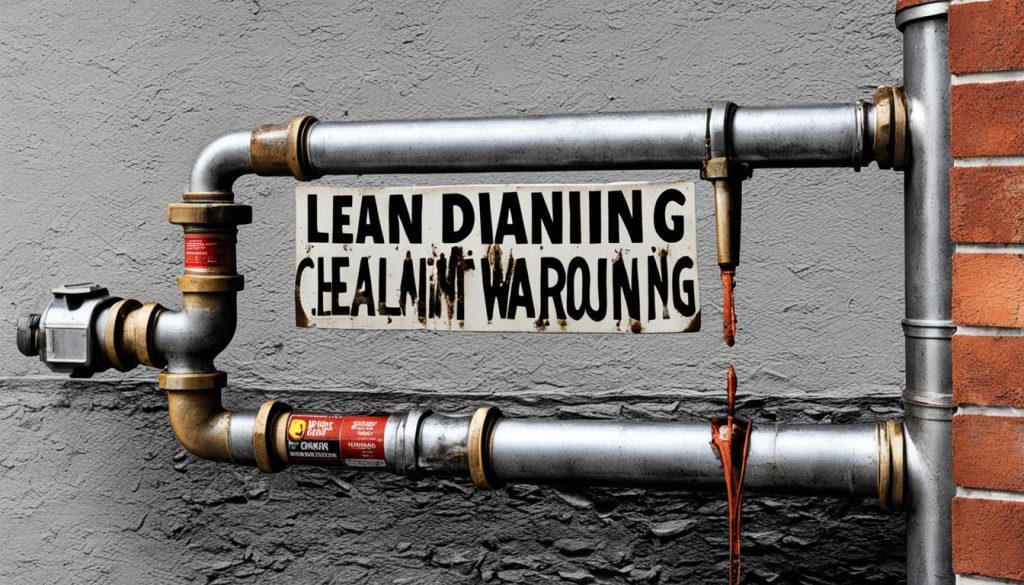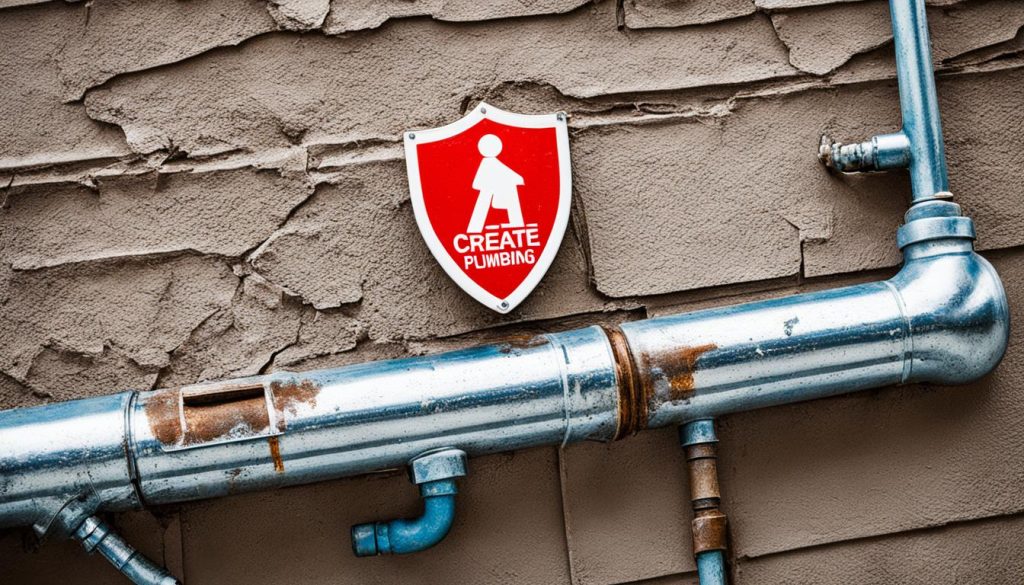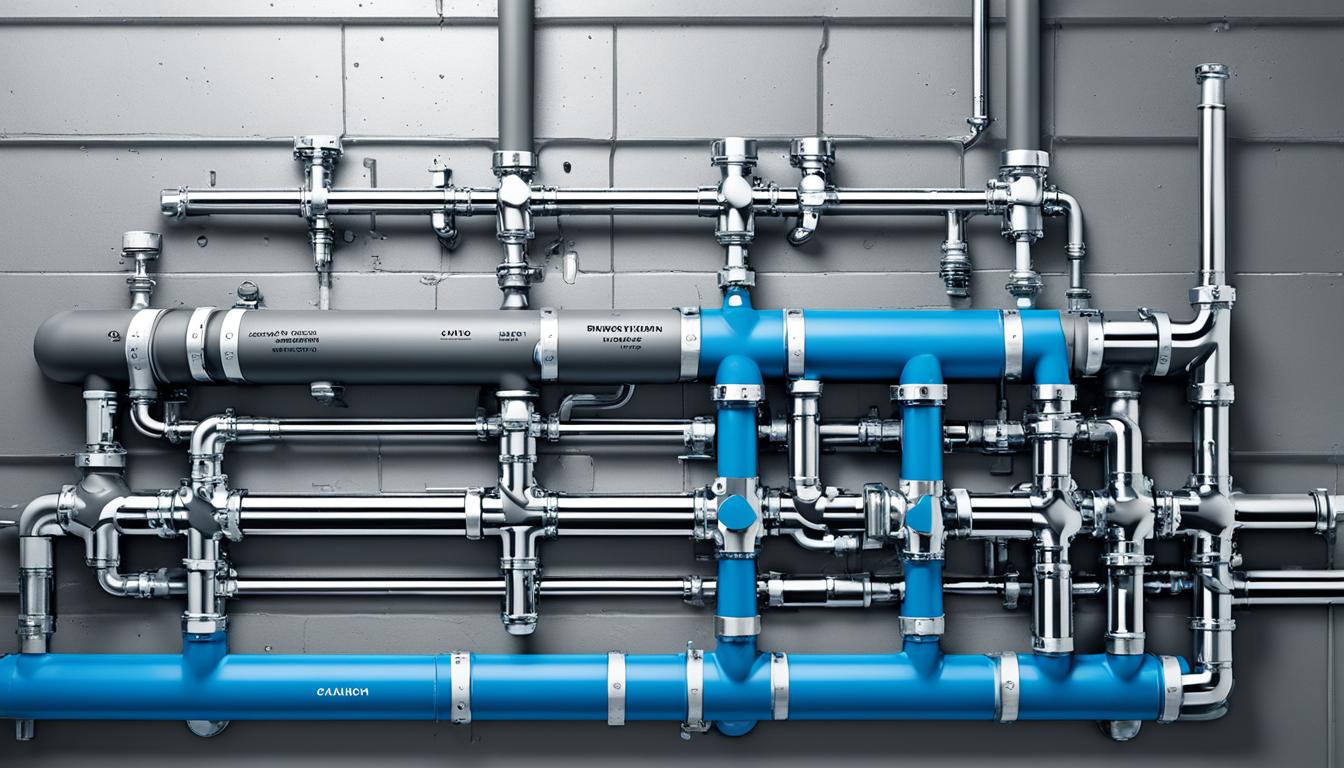Did you know that galvanized steel plumbing pipes were commonly installed in homes prior to 1950, with some sources suggesting their use continued until the 1960s?[1]
Galvanized plumbing, which involved coating steel pipes with zinc to prevent rusting, was once a popular choice for residential plumbing systems. However, over time, it became clear that these pipes posed risks to the integrity of the plumbing system.
Key Takeaways:
- Galvanized steel plumbing pipes were commonly installed in homes prior to 1950[1].
- Some sources suggest that galvanized plumbing continued to be used until the 1960s[1].
- The use of galvanized plumbing decreased significantly due to the risks of rust, corrosion, and reduced water pressure.
Now, let’s explore the life expectancy of galvanized plumbing and the potential risks it poses.
The Life Expectancy of Galvanized Plumbing
Galvanized steel pipes have an average life expectancy of 40 to 50 years. However, since they have not been installed since at least the 1960s, most, if not all, galvanized pipes currently in use have exceeded their expected lifespan. As these pipes corrode from the inside, leaks and collapses can occur, leading to reduced water pressure and the potential for flooding. Therefore, it is advisable to consider upgrading old galvanized pipes to more modern and durable alternatives.
Upgrading old galvanized pipes not only ensures the safety and integrity of your plumbing system but also offers several benefits. By replacing outdated galvanized pipes, you can improve water flow and pressure, reduce the risk of leaks and ruptures, and enhance the overall performance and efficiency of your plumbing system.
The History of Galvanized Plumbing
Galvanized plumbing was widely used in homes prior to the 1960s. The process of galvanizing involved coating steel pipes with zinc to protect them from rust and corrosion. At the time, it was considered a reliable and affordable option for plumbing installations. However, as the years passed, it became evident that galvanized pipes deteriorate from the inside, leading to various issues such as reduced water pressure, leaks, and potentially harmful contaminants in the water supply.
Benefits of Upgrading Old Galvanized Pipes
Upgrading old galvanized pipes brings numerous advantages. Firstly, it eliminates the risks associated with corroded pipes, such as water leaks and potential flooding. Additionally, modern piping materials like copper, PEX (cross-linked polyethylene), or PVC (polyvinyl chloride) offer improved durability, longevity, and resistance to rust and corrosion. These materials also ensure better water quality and flow, contributing to the overall efficiency and functionality of your plumbing system.
Furthermore, upgrading to newer pipes can potentially increase the value of your property, as it demonstrates a proactive approach to maintenance and addresses potential issues before they become more significant and costly.
Overall, investing in the upgrade of old galvanized pipes is a worthwhile endeavor that can provide long-term benefits for your home’s plumbing system and your peace of mind.
Note: The image above depicts the process of upgrading old galvanized pipes to modern, durable alternatives.
The Risks of Galvanized Plumbing
One of the major risks associated with galvanized plumbing is the potential accumulation of lead. Galvanized piping, particularly when it corrodes, has been found to release lead that has leached into the water from old lead service lines. This can pose significant health concerns, especially for children, as lead poisoning can lead to various symptoms and long-term health issues.
Additionally, the corrosion of galvanized pipes can result in reduced water pressure, leaks, and the presence of rust in the water supply. Switching from galvanized plumbing to more modern alternatives can help mitigate these risks.
The Impact of Lead in Galvanized Pipes
One of the primary concerns with galvanized plumbing is the presence of lead. Over time, lead can accumulate in the pipes and leach into the water, posing serious health risks. Lead exposure can lead to developmental delays, neurological damage, learning difficulties, and other adverse effects, particularly in young children.
Lead-contaminated water is a well-documented public health issue, and eliminating the source of lead is crucial in ensuring the safety of the water supply. By switching from galvanized plumbing to alternative materials such as copper or plastic pipes, the risk of lead contamination can be significantly reduced.
The Benefits of Switching From Galvanized Plumbing
There are several benefits to switching from galvanized plumbing to more modern alternatives:
- Improved water quality: By eliminating the risk of lead contamination, switching to alternative plumbing materials ensures cleaner and safer drinking water.
- Reduced maintenance and repair costs: Galvanized pipes are prone to corrosion and leaks, leading to frequent repairs and replacements. Upgrading to more durable materials can result in long-term cost savings.
- Increased water pressure: Corroded galvanized pipes can restrict water flow, resulting in low water pressure. Switching to modern plumbing materials can improve water pressure and provide a better overall experience.
- Enhanced longevity: Galvanized pipes have a limited lifespan and may require replacement after 40 to 50 years. Upgrading to alternative materials can provide a longer-lasting and more reliable plumbing system.

| Galvanized Plumbing Risks | Benefits of Switching |
|---|---|
| Potential lead accumulation | Improved water quality |
| Corrosion and leaks | Reduced maintenance and repair costs |
| Reduced water pressure | Increased water pressure |
| Rust in the water supply | Enhanced longevity |
Galvanized Plumbing Replacement Timeline
In order to determine when to replace galvanized plumbing, it is essential to consider the condition and age of the existing pipes. Galvanized pipes installed prior to the 1960s have typically surpassed their expected lifespan and should be evaluated for replacement. Monitoring the pipes for signs of corrosion, leaks, or rusty water, as well as maintaining awareness of water pressure, can help determine the appropriate timing for replacement. Consulting with a professional plumber to assess the condition of the plumbing system and establishing a replacement timeline is highly recommended.
Table: Signs that may indicate the need for galvanized plumbing replacement
| Signs | Description |
|---|---|
| Corrosion | Rust or damage on the pipes, especially around joints |
| Leaks | Visible or hidden water leaks along the pipes |
| Rusty water | Discolored water coming out of faucets |
| Reduced water pressure | Noticeable decrease in water pressure throughout the plumbing system |
Insurance Considerations for Galvanized Plumbing
When it comes to galvanized plumbing, insurance companies have specific requirements and considerations in place. Understanding these insurance implications is essential for homeowners with galvanized pipes.
Some insurance policies may require homeowners to replace galvanized plumbing with copper or plastic piping before providing coverage. This is because galvanized pipes pose an increased risk of leaks and water damage. By replacing galvanized pipes with more durable alternatives, such as copper or plastic, homeowners can minimize the insurance risks associated with galvanized plumbing.
Alternatively, insurance companies may increase water damage deductibles or limit coverage for homes with galvanized plumbing. This is because the corrosion and rust associated with galvanized pipes can lead to significant water damage and costly repairs. Insurance companies may view homes with galvanized plumbing as higher risk and adjust policies accordingly.
Reviewing insurance policies is crucial for homeowners with galvanized plumbing. By understanding the potential financial implications and limitations related to galvanized pipes, homeowners can make informed decisions about their insurance coverage.
It is worth noting that insurance coverage for galvanized plumbing is not guaranteed. Homeowners must be proactive in addressing potential insurance concerns and taking steps to minimize the risks associated with galvanized pipes.
To summarize, some insurance policies require replacing galvanized plumbing, while others may limit coverage or increase deductibles for homes with galvanized pipes. By understanding these insurance considerations, homeowners can take the necessary steps to protect their investment and minimize the financial risks associated with galvanized plumbing.

Here is a table summarizing the insurance implications for galvanized plumbing:
| Insurance Implications | Summary |
|---|---|
| Insurance Requirements | Replace galvanized plumbing with copper or plastic pipes for coverage |
| Policy Adjustments | Increased water damage deductibles or limited coverage for homes with galvanized plumbing |
| Financial Risks | Potential for water damage and costly repairs without adequate coverage |
| Proactive Measures | Review insurance policies and consider upgrading galvanized plumbing to minimize risks |
Water Damage Risks and Prevention
Galvanized plumbing is known for its susceptibility to corrosion, which increases the risk of water damage in homes. Recognizing the signs of potential water damage can help homeowners take proactive measures to prevent costly repairs and protect their property.
Signs of Water Damage from Galvanized Plumbing
There are several indicators that can suggest water damage resulting from galvanized plumbing:
- Rust around pipe joints: Visible rust around pipe connections is a clear sign of potential water damage. It indicates that the galvanized pipes may be corroded and at risk of leaks or ruptures.
- Pitted rust spots: Pitted rust spots on the surface of pipes suggest that corrosion has already occurred. These areas may be weak and prone to leaks.
- Brownish water from faucets: Discolored water, particularly brownish or rusty water, is a strong indication of deterioration in galvanized pipes. It is essential to address this immediately to prevent further damage.
- Reduced water pressure: Calcium buildup inside galvanized pipes can contribute to reduced water pressure. If you notice a significant decrease in water flow, it may be a sign that your galvanized pipes are deteriorating.
Preventing Water Damage from Galvanized Plumbing
Proactive maintenance and regular inspections can help prevent water damage associated with galvanized plumbing. Here are some essential preventive measures:
- Inspect grout and seals for leaks: Regularly check the grout and seals around bathtubs, showers, and sink fixtures for any signs of leaks or water damage. Timely repairs can prevent water from seeping into walls or floors.
- Install leak detection systems: Consider installing leak detection systems that can alert you to potential leaks or water damage. These systems can provide early warnings and help minimize the extent of damage.
- Check the basement after rainfall: After heavy rainfall, inspect your basement for any signs of water intrusion. This can help identify potential leaks or drainage issues that require attention.
- Replace worn-out water supply hoses: Over time, water supply hoses can deteriorate and develop leaks. Regularly inspect and replace worn-out hoses to prevent sudden bursts or leaks that could lead to water damage.
- Store valuables in safe places: If you have concerns about potential water damage, consider storing valuable items in elevated or waterproof containers to protect them from potential leaks or flooding.
- Address drainage issues: Proper drainage systems around your home can help divert water away from the foundation and prevent water damage.
By being proactive and implementing these preventive measures, homeowners can significantly reduce the risk of water damage associated with galvanized plumbing. Regular inspections, timely repairs, and the consideration of alternative pipe materials can help ensure a reliable and leak-free plumbing system.
The Dangers of Galvanized Piping in Softened Water Systems
Galvanized plumbing presents significant risks when used in softened water systems. While the process of water softening aims to reduce the scaling caused by calcium carbonate, it inadvertently creates a corrosive environment for galvanized pipes. The protective zinc coating on these pipes is quickly eroded, leading to accelerated corrosion.
This corrosion can cause various types of damage, including pitting and leakage, within a relatively short period. The combination of softened water and galvanized plumbing becomes a recipe for potential plumbing disasters. To avoid these issues, it is crucial to steer clear of using galvanized pipes in hot, softened water systems.
Thankfully, there are excellent alternatives available for these applications. Materials like copper, PVC, and stainless steel offer superior durability and resistance to corrosion, making them ideal choices for softened water systems. By opting for these reliable alternatives, homeowners can significantly reduce the risk of plumbing failures and enjoy a more secure and efficient water supply.
Source Links
- https://mmengineering.com/wp-content/uploads/2013/10/Conduit-Vol.-12-No.-3.pdf
- https://americanvintagehome.com/blog/need-swap-galvanized-pipes/
- https://www.squareone.ca/resource-centres/getting-to-know-your-home/galvanized-steel-plumbing
